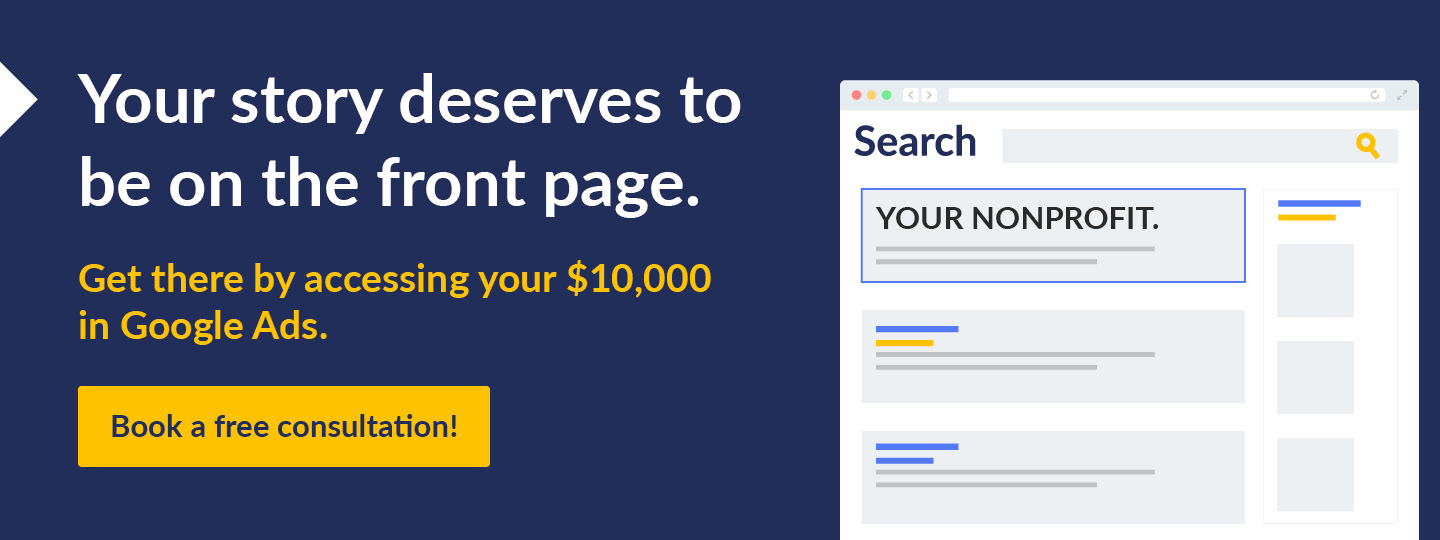4 Ways to Win Donors’ Hearts with Nonprofit Storytelling
When it comes to marketing your nonprofit’s mission and connecting with donors on a deeper level, nothing is better than an engaging story.
Your nonprofit storytelling needs to capture your audience’s attention, clearly explain the problem you’re facing, and empower supporters to be a part of the solution. Ultimately, it should inspire donations and other forms of support. In this guide, we’ll walk through:
- Why Is Nonprofit Storytelling Important?
- What Are The Elements Of Nonprofit Storytelling?
- Take Your Nonprofit’s Storytelling To The Next Level
- Apply for the Google Grant with Getting Attention
Because nonprofit storytelling is a critical component of your overall marketing strategy, it’s essential to hone your skills. Let’s get started!

Why Is Nonprofit Storytelling Important?
It’s hard to forget a good story. While we might not remember the specific facts or details, storytelling is still one of the best ways to connect with other humans and share an experience.
Additionally, studies show that roughly 70% of companies invest in content marketing to convey stories to their audiences. With so many organizations investing in this method, there are clearly real benefits to using storytelling in marketing strategies.
Storytelling Benefits To Your Nonprofit
Here are the top benefits a dedicated nonprofit storytelling strategy can bring you:
- Increased fundraising revenue. Your nonprofit’s storytelling efforts can be the exact conduit you need to inspire donors to give. The key to motivating them to give is to land your story in front of the right audiences.
- Improved click-through rate and online conversions. Because stories tend to be more engaging, you’ll likely see an increase in the number of people who click on your website, social media posts, or Google Ads.
- Larger membership base. Does your nonprofit organization have a membership program dedicated to your most passionate supporters? Nonprofit storytelling is one of the best ways to attract membership candidates who connect deeply to your cause.
- Better donor appreciation. Donor appreciation is a critical component of building lasting relationships and increasing retention. Instead of just sending a bland thank you email, incorporate storytelling to share a thought-provoking, real story about how their support made a difference.
Another key benefit of nonprofit storytelling is that your supporters will be more informed about your cause and your organization’s needs. Seeing the impact of your work through testimonials from beneficiaries will remind them of the good that their contributions enable.
What Are The Elements Of Nonprofit Storytelling?
Compelling Characters
Every good story needs a hero. For your nonprofit story, you’ll need a compelling character to act as the main lead and inspire support.
This “character” should be a real person who has been impacted by your nonprofit in some way. For example, you might choose to center one of these supporters in your story:
- A dedicated volunteer
- A long-term, major donor
- A beneficiary who is willing to share their personal story
- A staff member
To translate details about these supporters or beneficiaries to your audience, you’ll need to use more traditional storytelling methods. Here are some ways to capture their personalities and emotions on screen or paper:
- Establish a face and name. Put a face to this individual by attaching a photo and name to the story. This instantly makes the story feel more personal to viewers.
- Give them a distinct voice. Make your character feel three-dimensional to your audience by highlighting personal details. Show off their unique way of speaking about their experiences or their background that led them to engage with your nonprofit.
- Show how they were impacted by your organization. The resolution for this story should be shaped by your nonprofit’s involvement in the character’s life. Clearly show how your organization led them to this key moment.
For example, Feeding America includes these stories from Native American women working towards food security on their website. The nonprofit includes their names, a photo of them, and an explanation of how they are supporting the cause:
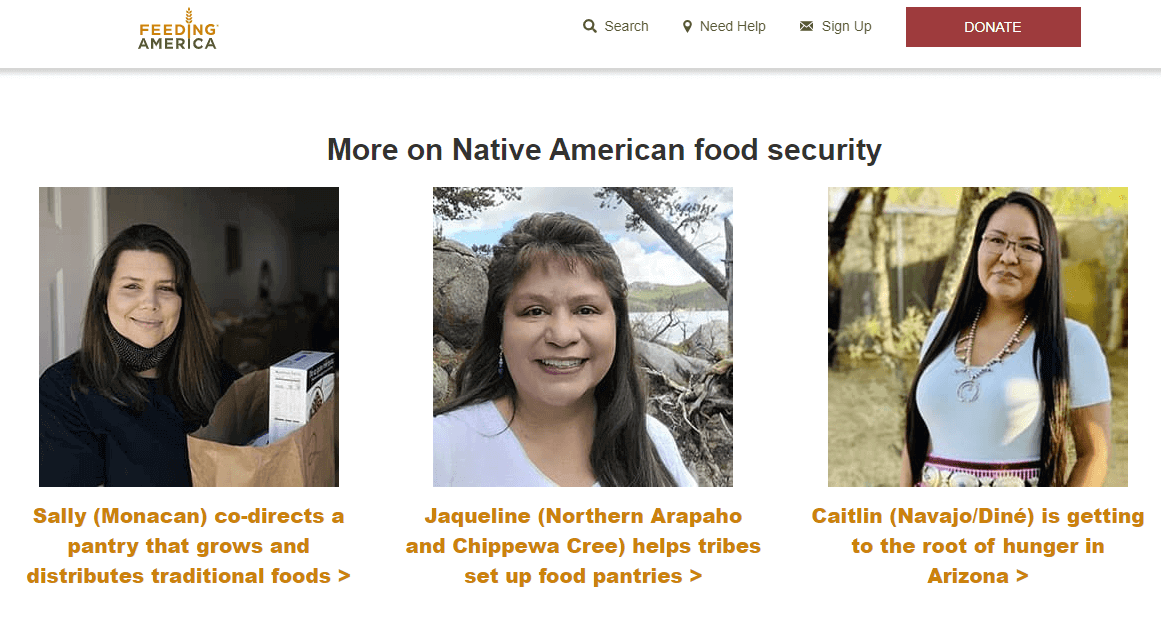
When you involve real people in your stories, remember to consider the ethics of the story you’re telling. As the nonprofit, you are in a position of power—especially if the subject is a beneficiary. Lead with their best interests first, and never indicate that your services are contingent upon their participation in the storytelling campaign. Everything presented in the campaign must be honest and transparent.
Dramatic Arc
The dramatic arc is what hooks your audience, gets them invested in your narrative, and empowers them to play their own role in the story.
Here are the five main elements of a dramatic arc:
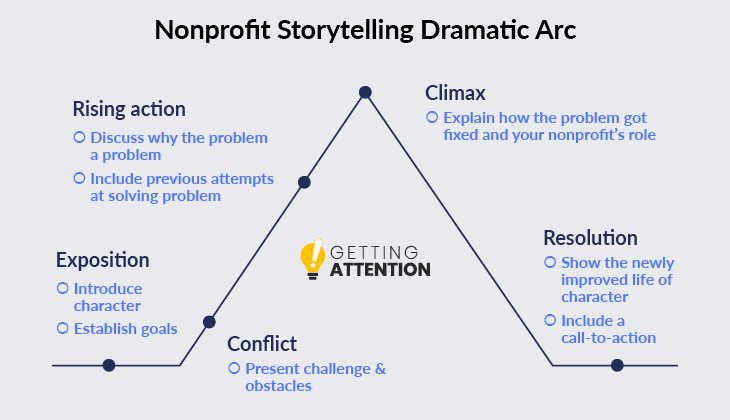
- Exposition. Introduce your character and establish goals related to your mission. If your mission is to provide clean water, for example, one of your character’s goals could be ensuring that his family stays healthy after getting sick from dirty water.
- Conflict. Here, you’ll present the challenge that your character is facing. The conflict should be related to the problem your nonprofit is trying to solve. In our water example, this could be that the family’s water source was polluted with chemicals. Consider all the obstacles your character might face, like a lack of resources or policy knowledge.
- Rising action. Next, lay out the stakes and explain why the problem is a problem. You might also highlight previous attempts to solve the issue. For instance, you might say that the local town has needed clean water for a while, but an increase in spills from nearby factories has made it difficult to keep the infrastructure in place.
- Climax. This is where you’ll explain how the problem got fixed and the exact role that your nonprofit plays. What did your nonprofit do? What was the specific action that made the difference? For example, with help from your annual fundraising campaign, your nonprofit was able to build a clean water infrastructure system that is easy to fix and regulated yearly.
- Resolution. Show the newly improved life of the character in your story. Urge the audience to play a part by calling them to donate, share a message, or volunteer.
As you’re crafting your story, remember to be as clear as possible about the goals of the character, the challenges they face, and how exactly your nonprofit and audience can help. These are the most important aspects of the story, and they need to shine through for your nonprofit to make an impact.
Solution
The solution to your story provides proof that your organization truly makes a difference. When explaining your solution, you should:
- Empower the donors to be a part of the story by making the next action they should take clear.
- Use language that creates a sense of urgency by mentioning a specific deadline and explaining what would happen if your nonprofit is unable to act.
- Make it convenient for the audience to take action by including a donation button, link to signup forms, or social sharing buttons with your request.
For example, Step Up For Students created a blog post highlighting the story of a scholarship recipient attending Notre Dame who achieved salutatorian status in his class (note the prominent donation button in the sidebar!):

4 Best Practices To Take Your Nonprofit’s Storytelling To The Next Level
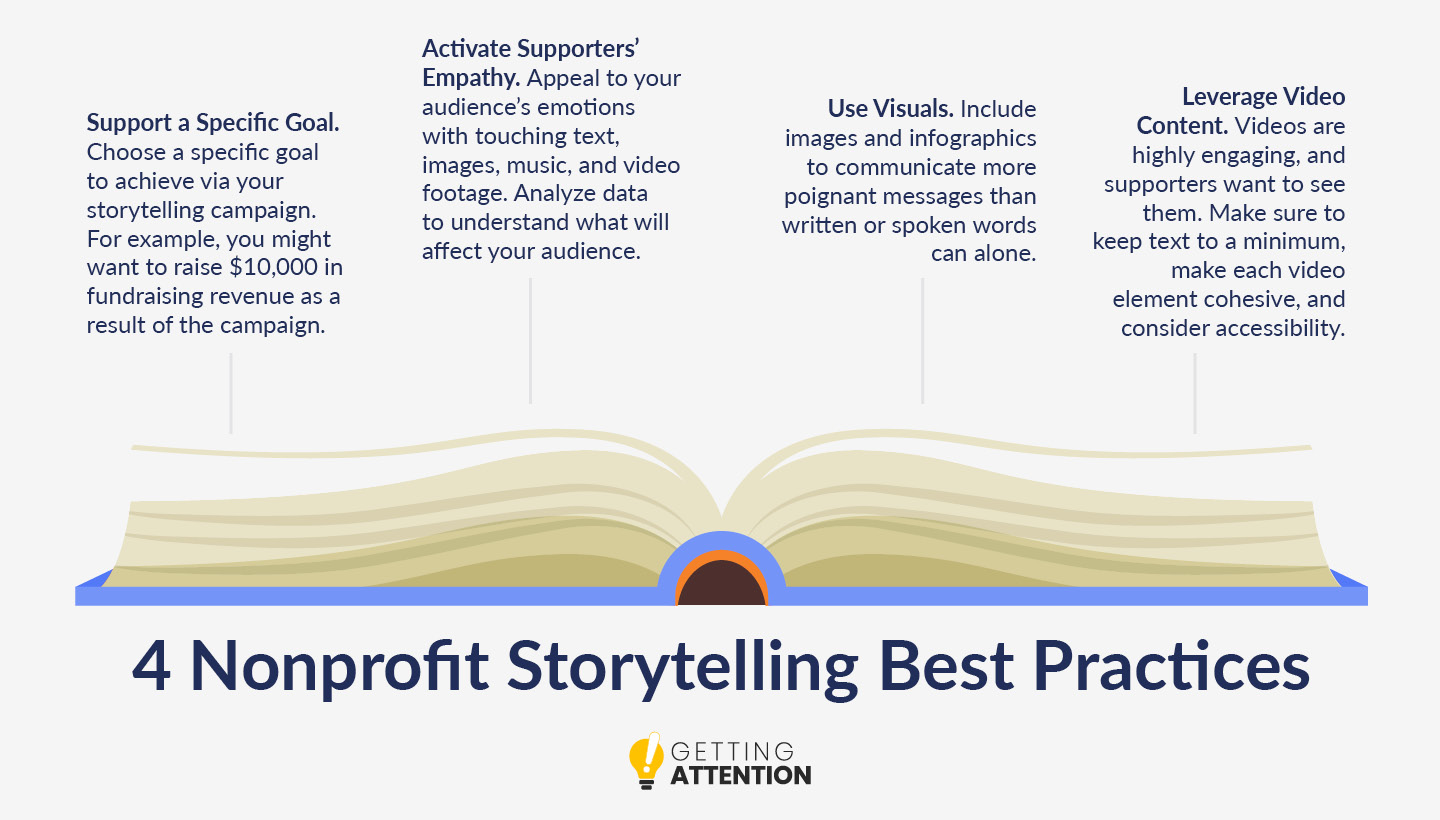
1. Support a Specific Goal
Make sure you have a specific goal or action at the center of your narrative. The goal you pick will depend on your unique needs and audience, but here are some examples to get the ball rolling:
- Raise $10,000 in revenue as a direct result of the storytelling campaign.
- Grow your membership program by 100 members.
- Send personalized thank-you messages to each donor within one week of their gift.
- Boost donor engagement on your social media accounts by 25%.
To improve your fundraising strategy beyond this single campaign, look at your database and make note of engagements or key performance indicators (KPIs) that are falling short. Then, craft a story to support that area, and make sure to note it as a priority for future marketing efforts.
Want marketing tips and tricks to help you reach your goals? Sign up for our newsletter!
2. Activate Supporters’ Empathy
Making supporters feel something is the main conduit to whether or not they will feel passionate about your mission and decide to give.
This example from the ASPCA’s homepage makes an emotional appeal by using images of the animals that they work to aid, asking supporters to help them:
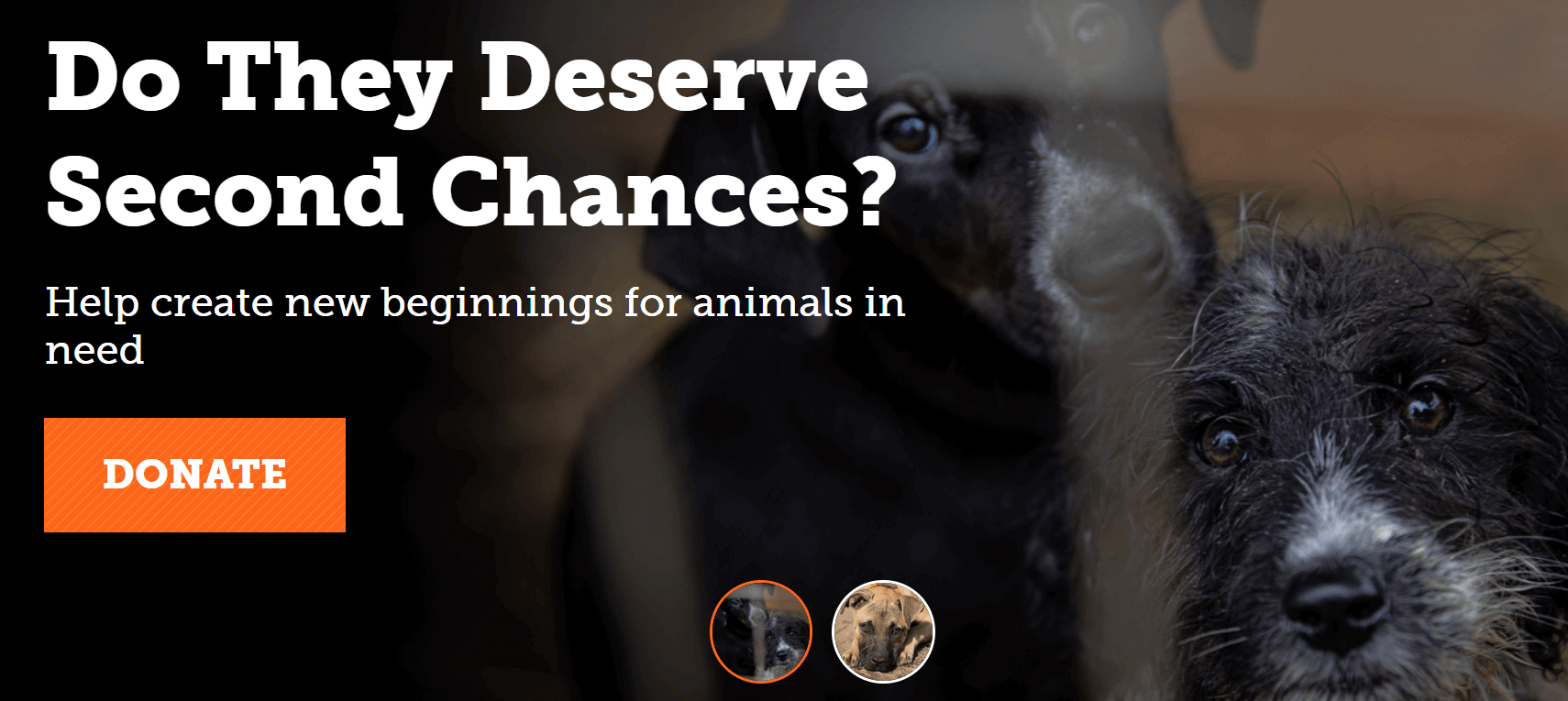
Before you can activate your own supporters’ empathy, it’s key to understand your audience so you know why donors choose to support your cause. Analyze data about your supporters like their past philanthropic involvement, political contributions, and demographic information to get a feel for their personal values. Then, pinpoint those values in your story.
To make an emotional appeal, make sure to closely follow and highlight your character’s emotions. Aim to center their perspective so your audience feels like they are walking in the supporter or beneficiary’s shoes. To immerse them in the story, remember to describe sensory details like sounds, smells, and feelings.
3. Use Visuals
Visuals help evoke emotion from your audience, leave a lasting impression in your supporters’ minds, and build your organization’s brand.
The best part is that visuals can take so many forms nowadays and can supplement your storytelling in different ways:
- Photos. Images bring a real face to the story you’re telling, helping supporters understand that their help is impacting real people. At your next fundraising event or volunteer opportunity, make sure to take photos (and get permission to use them).
- Infographics. These graphics convey a wide breadth of information in an easily digestible format. Ideas include using charts, maps, reports, and other fun graphics to help your audience visualize data and understand your impact.
Look through your own arsenal of marketing materials and determine if any of your visuals are viable for use in your nonprofit story.
4. Leverage Video Content
In a 2023 study, 91% of people surveyed said that they want to see more online videos from organizations—satisfy this demand with your storytelling strategies.
To create an effective video, follow these best practices:
- Keep on-screen text to a minimum. Narrate the video as much as you can so participants don’t have to read long paragraphs. If you need to use on-screen text, stick to about 60 words per minute of the video and allow for one second of read time for every two to three words.
- Make the video cohesive. Make sure the music and supporting media (like images or copy) match the overall theme of the story. These added elements can go the extra mile in making your supporters feel a certain way.
- Consider accessibility. Be sure to add closed captions to the video for any spoken dialogue or other sounds (hint: platforms like YouTube can do this automatically!). Not only does this make the video content accessible to more of your supporters, but people can view the video without audio and still understand your message.
For inspiration, check out this video from the World Wildlife Fund. It shows the importance of each tiny piece of an ecosystem and encourages people to “love it” by supporting WWF (or risk losing it):
Apply for the Google Grant with Getting Attention
Spreading awareness of your nonprofit and reaching new people with your carefully crafted stories will be the final, often most difficult, step in nonprofit storytelling. Traditional marketing channels like television can be costly, and you might feel overwhelmed by the vastness of digital marketing.
To receive professional help and get $10,000 in Google Ads for free, consider working with a Google Ad Grants agency.
If you aren’t familiar, the Google Grant is a program hosted by Google that gives $10,000 in Google Ad credits to nonprofit organizations each month. The purpose of this grant is to help nonprofits promote valuable digital content (like your stories!) to their supporters.
To gain access to the program, your nonprofit will need to apply, maintain compliance, target relevant keywords, and manage multiple ad campaigns. Getting Attention is a Google Ad Grant agency that’s ready to help you apply and manage your Google Ad campaigns.
Additional Resources
People are inspired by, learn from, and remember stories. Your nonprofit already has a compelling story: a built-in goal (mission) and antagonist (issue) to drive the narrative forward and captivate your audience members. Take advantage of this story waiting to be told in your next campaign.
To learn more about how you can level up your nonprofit marketing, explore these additional resources:
- Nonprofit Marketing: A Guide for Amplifying Your Mission. Ready to learn more about nonprofit marketing? Check out this comprehensive guide.
- Nonprofit Marketing Plan in 8 Steps (+ Free Templates!). With a solid foundation in nonprofit storytelling, you start building a comprehensive marketing plan for your organization.
- Technology Grants for Nonprofits: A Guide + 12 Top Options. Intrigued by the world of Google Ad Grants? Learn more about the program and other nonprofit tech grants in this guide.

